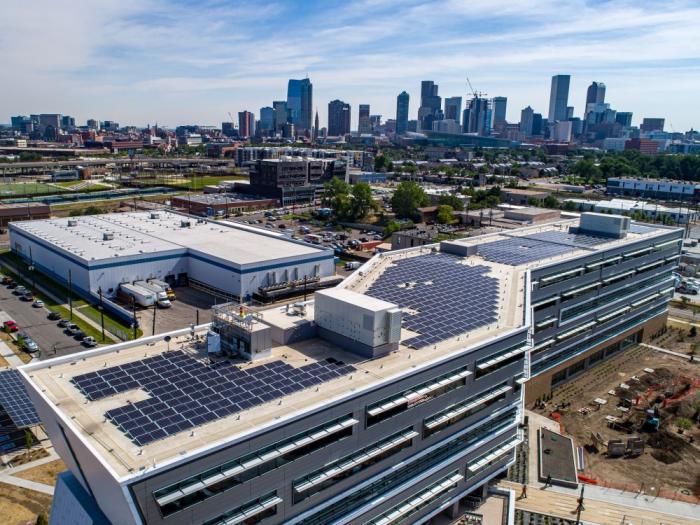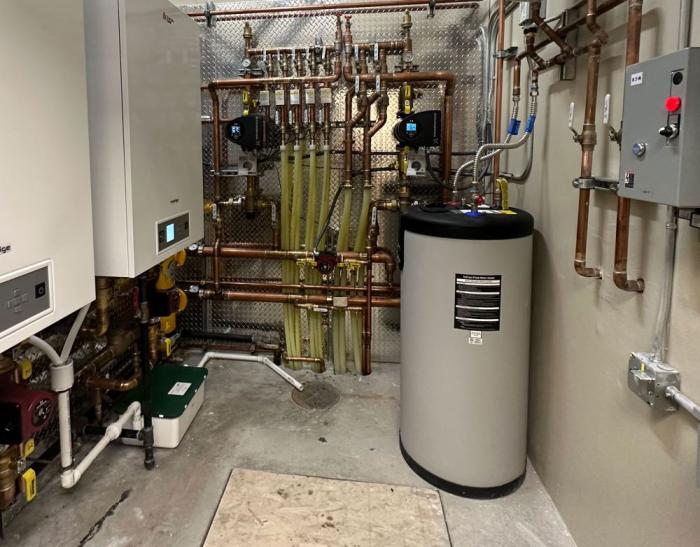Giga-WHAT? We cut 1M kilowatt-hours, that’s what
Denver Water’s mission is water, but efforts to cut energy use and carbon emissions have become more front and center over the last decade.
After all, climate change threatens water supplies, so water utilities need to do their part to reduce the fossil-fuel ingredients that are warming the atmosphere and jeopardizing snowfall and river flows.
Already, Denver Water powers its main Administration Building with solar panels, harnesses the power of water to generate enough hydroelectricity to juice 6,000 homes and employs a system that uses water, not air, to heat and cool its headquarters, making it easier and cheaper to keep temperatures comfortable.
But it’s not stopping there.
Always on the lookout for new sustainability features, Denver Water last year set a goal to cut its energy use by one gigawatt-hour. That’s 1 million kilowatt-hours — a ton of electricity (or, in some cases, the equivalent amount of fuel, like gasoline) — enough to power 750,000 homes for one hour, or roughly 100 homes for a year.
And, in the last 12 months, the utility accomplished its goal.
Employees scoured the organization for low-hanging fruit, the relatively easy fixes that could be done at little or no cost or would provide a rapid payback by quickly cutting energy expenses.
It takes all kinds of passionate people to ensure a clean, safe water supply for 1.5 million people. Join the team at denverwater.org/Careers.
And it unleashed its in-house expertise, including personnel specializing in electrical, HVAC, plumbing, information technology, vehicle fleet, dams, reservoirs and the network of pipes that moves water through the city.
Teams pinpointed energy savings that could be snared by closing unused facilities that were still drawing power, replacing outdated boilers in the utility’s Winter Park facilities, updating old lighting, reducing the idling of fleet trucks (which wastes gas and diesel) and adding its first batch of electric vehicles — among other steps.
“This was an energy treasure hunt,” said Adam Hutchinson, an energy management specialist and part of Denver Water’s Sustainability Team. “We’ve focused on energy efficiency for many years now, but we wanted to take another hard look across the organization for relatively quick and easy energy-saving opportunities.”
Hunt they did, and Denver Water employees put their expertise to work to find savings large and small.
Some of the finds were big, like taking out a problem boiler used to heat a key Denver Water facility in Winter Park, home to workers and a fleet of heavy equipment that helps keep things running in the high country.
The new equipment installed in Winter Park was more energy efficient, with an efficiency rating of 96% (compared to the old boiler’s 80% efficiency), and the switchover saved some 300,000 kilowatt-hours of electricity per year.
“We installed a more efficient boiler that uses flue gas that would otherwise be expelled. The new equipment keeps it in the boiler to provide more heat,” said Jeffrey Gulley, who leads the trade shop for Denver Water. “We wanted to have efficiency and reliability with the frigid temperatures up there.”
The utility’s transmission and distribution employees determined that a few small, scattered facilities in the metro area could be closed and their functions consolidated. That amounted to cutting another 100,000 kilowatt-hours via reductions in heating, cooling and lighting.
Smaller changes also added up.
At Marston Treatment Plant in southwest Denver, an air bubbler keeps the water intake from freezing in winter months. Typically, the bubbler stays on constantly from November through May. But the simple addition of a temperature sensor means the bubbler can shut down when winter weather hits a warm stretch.
And boom! That simple sensor produced another 9,000 kilowatt-hours of savings — enough to pay for itself in 18 months.
All told, the gigawatt project fit cleanly into the second phase of Denver Water’s Sustainability Plan, which includes a goal to reduce greenhouse gas emissions by 50% by 2025 from a 2015 baseline.
And it chips away at a broader strategy: To drive down energy usage as low as possible, then get what power you still need through renewable energy.
“All of this aligns with Denver Water’s overall push to aggressively do our part to address climate change,” said Kate Taft, the utility’s sustainability manager. “On the water planning side, we must adapt to the ongoing changes, but we can work on our operations side to reduce our own footprint. That is why we continue to move forward with change.”
And continue it does. After reaching the 1-gigawatt (that is, 1 million kilowatt-hours) goal, ongoing work has found more savings.
Denver Water is now at 1.2 million kilowatt-hours in energy savings since setting the goal a bit over a year ago.
And all of this isn’t good news only for the environment. By cutting energy costs, Denver Water can also keep expenses down.
“We’re driven on our sustainability goals,” Hutchinson said. “Along with that, we’re keeping in mind our customers and our rates.”




